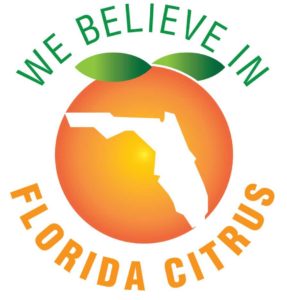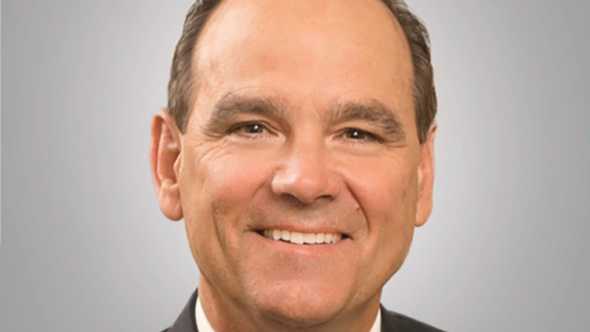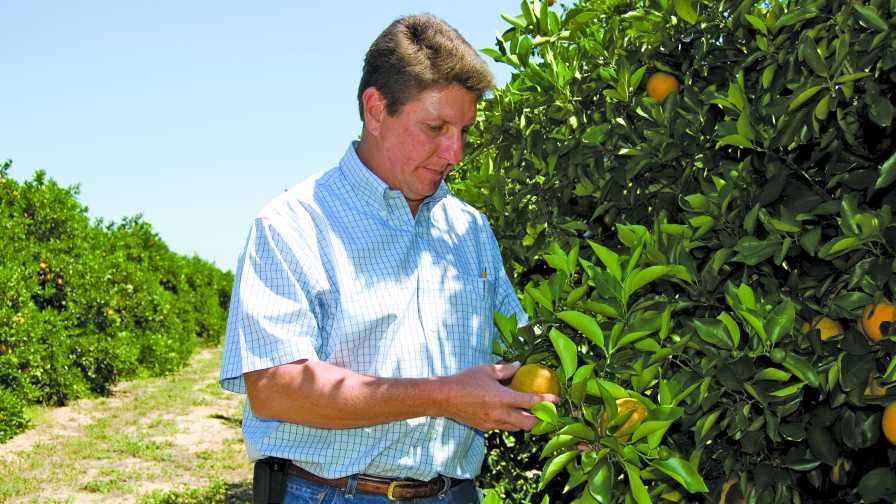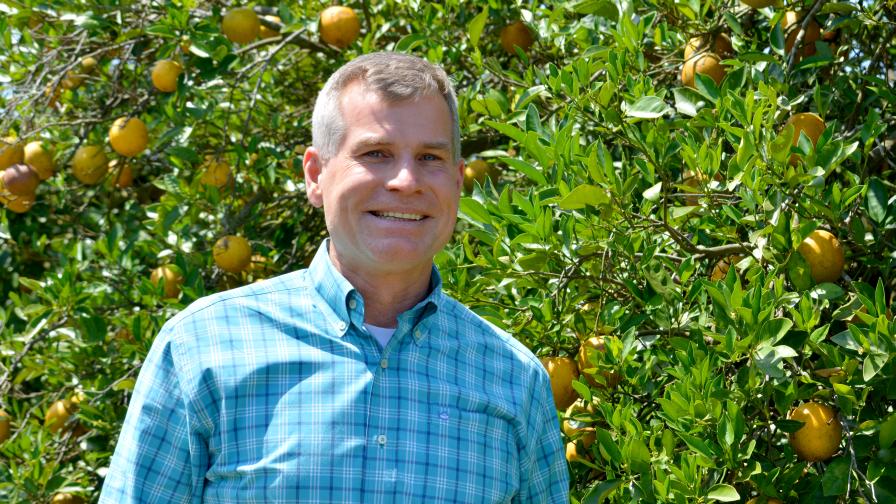
Congratulations to Larry Black for being named Florida Grower’s 2021 Citrus Achievement Award winner.
Photo by Frank Giles
For more than two decades, the Florida GrowerSM Citrus Achievement Award has honored outstanding industry advocates. This year is no exception. Larry Black, Vice President and General Manager of Peace River Packing, takes home the honor for his outstanding service to the industry and for leading by example with innovative growing practices.
When the first Citrus Achievement Award was presented to Phil Herndon in 2001, little did anyone know the toll HLB would exact on Florida’s signature crop as it spread across the state.
Despite the challenge, Black believes in Florida citrus and its future. He has modified production programs to try to keep trees productive in the face of HLB. And he believes eventually science will find ways to keep the disease in check.
“Unfortunately, we’ve learned there’s no silver bullet for HLB,” Black says. “HLB is a very complex bacteria, and finding solutions has been tough and elusive. When we first found the disease 15 years ago, I never imagined the dramatic impact on production. Today’s production is only a fraction of what it was back then.”
Having served on the board of the Citrus Research and Development Foundation (CRDF) for 10 years and its President for two of those years, Black is well versed in the scientific research aimed at fighting the disease. He says there is reason to believe there will be breakthroughs in fighting HLB, hopefully sooner than later.
Black is particularly excited about CRISPR (clustered regularly interspaced short palindromic repeats) — a powerful technology for editing genomes. “CRISPR is already being used and studied in a multitude of crops to improve quality and productivity. If we can take the existing varieties we know do well in Florida and edit out the genes that make the tree susceptible to HLB, that is an ideal solution.
“CRISPR technology could make that possible. I believe consumers are going to be more accepting of the technology because it is going to be applied in so many areas and doesn’t have the negative connotations like GMOs.”
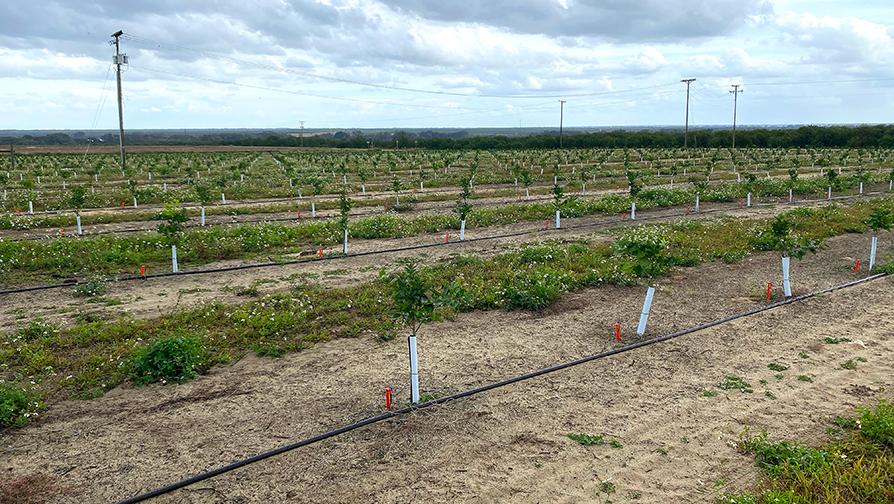
Larry Black says planting new trees is critical to maintaining infrastructure and production. Peace Rive Packing Company is replanting.
Photo courtesy of Peace River Packing Company
Well Represented
Black says for an industry that is relatively small — like Florida citrus — the sway it has in state and federal policy is impressive. In addition to serving on the CRDF board, he serves on the board of Florida Citrus Mutual.
“I cannot say enough about the efforts of Florida Citrus Mutual,” he says. “Their work to secure both state and federal dollars to fund the research efforts to fight HLB has been critical. They have really given us an audience with the policy makers to help create awareness of how challenging this disease has been and our need for funds.”
Black also credits research efforts funded directly by growers through box tax funds. A recent estimate suggests that about $1.4 billion (grower, state, and federal funding) has been spent on HLB research. He believes that expenditure, combined with grower collaboration with scientists, must bear fruit with longer-term solutions.
Black says CRDF has done a great job representing growers in guiding research efforts. Its board, comprised predominantly of growers, directs funds to various research projects.
“CRDF has been fortunate to have had a strong, grower-led board and leadership,” he says. “There are so many divergent interests among research institutions like USDA, University of Florida, other land grants, and growers who are impatiently, and rightly so, waiting on solutions to HLB. It takes a special kind of leader to manage that. Our current COO Rick Dantzler is that kind of leader, and so are members of the board.”
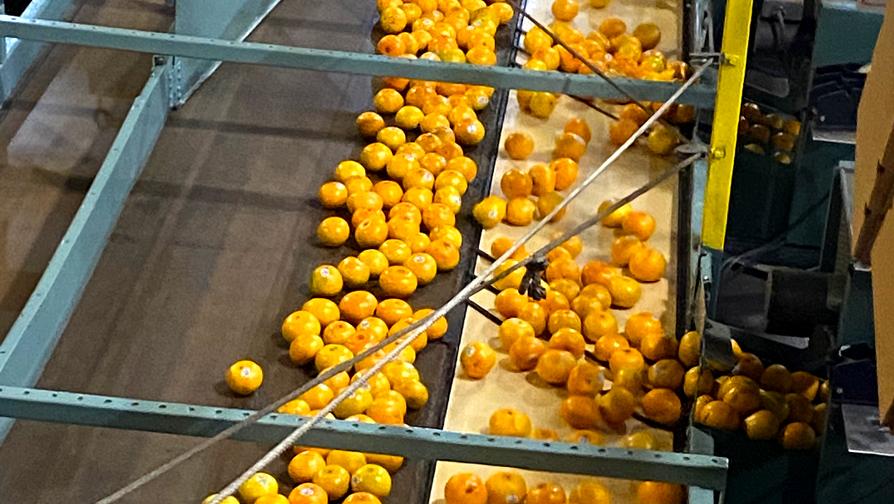
Duda Farm Fresh markets fresh fruit packed by Peace River Packing Company.
Photo courtesy of Peace River Packing Company
In an industry that is challenged, consolidating, and fighting for its future, Black says service is needed now more than ever and is rewarding.
“Serving on CRDF, Florida Citrus Mutual, and other organizations, I have always felt I got more from my service than I put into it,” he says. “The relationships I’ve established on a business and personal level have been a special part of my life. I have been able to take the things I’ve learned while serving back to benefit my business. I have had access to researchers, experts, and other growers, many of whom have become life-long friends. Every aspect of industry service has been valuable to me.”
Adjusting Production
Black, like other growers, has adapted his production program over the years to manage around HLB. Tree density has been increased from 140 to 150 trees per acre up to 270 to 300 trees per acre. Nutrition programs have been adjusted to spoon-feed nutrients to the roots and trees. They’ve also addressed bicarbonate levels in irrigation water.
“I really have to credit growers because a lot of these production changes were developed by them in the grove,” Black says. “They took that to the research community to study and confirm that these practices can help keep trees more productive than they otherwise would be in the presence of HLB.”
The farm also has placed an emphasis on new variety and rootstock evaluation. US-942 and US-812 are currently the go-to rootstocks on new plantings. Black is cooperating with plant breeders by participating in on-farm trials of new variety selections.
A Way of Life
Black says citrus has been an integral part of Florida’s history. The people who make up the industry are committed to ensuring it remains that way.
“We have a great industry, and from a very early age, I knew I wanted to be a part of it,” he says. “It is a central part of our lives here in Florida. It is the fabric of our communities. We have competitive advantages of growing citrus here. The climate, the soil, and the billion-dollar infrastructure we have built here gives us an edge. We have the three top juice brands right here in our back yard.
“I think there are going to be opportunities for growers to continue to produce here in Florida, and as more solutions to HLB come, we will grow our industry again and enhance production.”
Generations of Florida Citrus
Larry Black’s family has been growing citrus in Florida for generations. His great grandfather, D.H. Varn Sr., started Peace River Packing Company in 1928 in Ft. Meade. The family continues to own and operate the company through a cooperative structure. About half the company’s production is for processing, marketed by Florida’s Natural Growers. The other half is fresh fruit marketed by Duda Farm Fresh Foods.
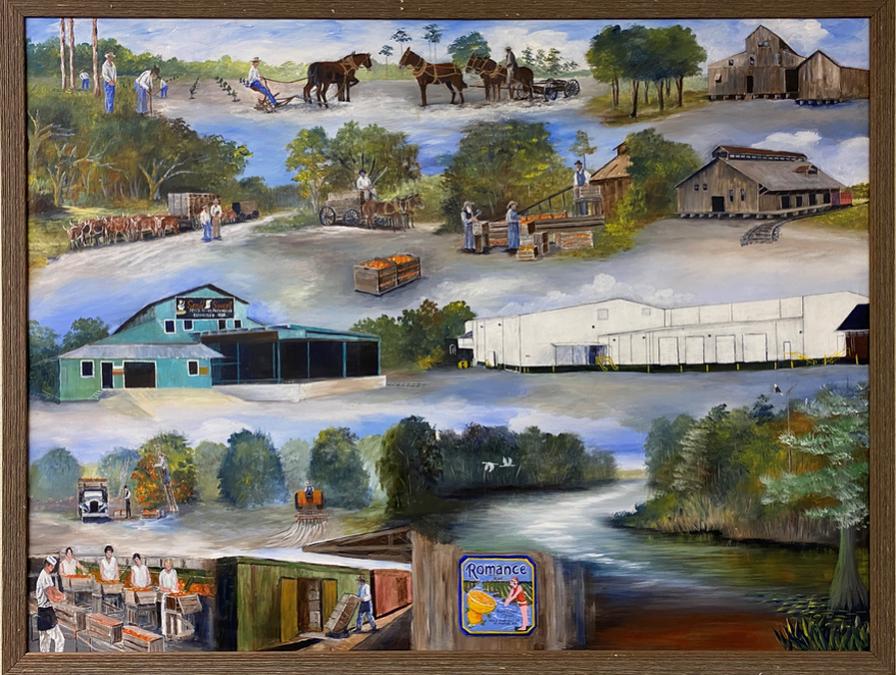
This painting, capturing the history of Peace River Packing Company, hangs in the office of the packinghouse in Ft. Meade.
Black and his wife, Jenny, own 625 acres of the 2,300 acres within the family cooperative. They have two children, Varn (17) and Julia (14).
Industry Peers Tip of the Hat to Larry Black
“Larry is one of the most logical and clear-headed thinkers I know. He sees all sides of issues. He speaks directly and doesn’t waste words. He is a Rock of Gibraltar for the Florida citrus industry.” — Rick Dantzler, COO, Citrus Research and Development Foundation
“Larry is always willing to share the successes that his company has experienced during the challenging times we company has experienced during the challenging times we have faced in our industry over the past 15 years. Larry’s willingness to serve on the CRDF board and the Florida Citrus Mutual board, as well as serving as President on both boards, is a demonstration of his unselfish dedication to our industry.” — Jim Snively, Vice President, Grove Operations, Southern Garden Citrus and 2008 Achievement Award winner










